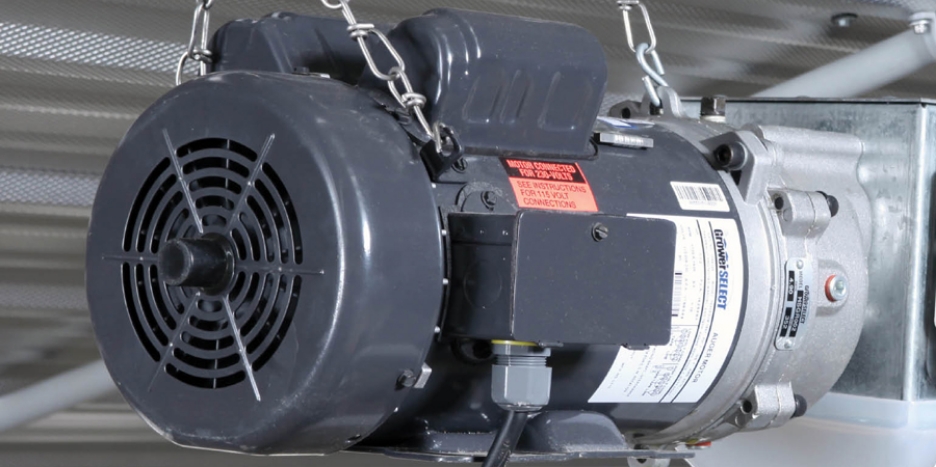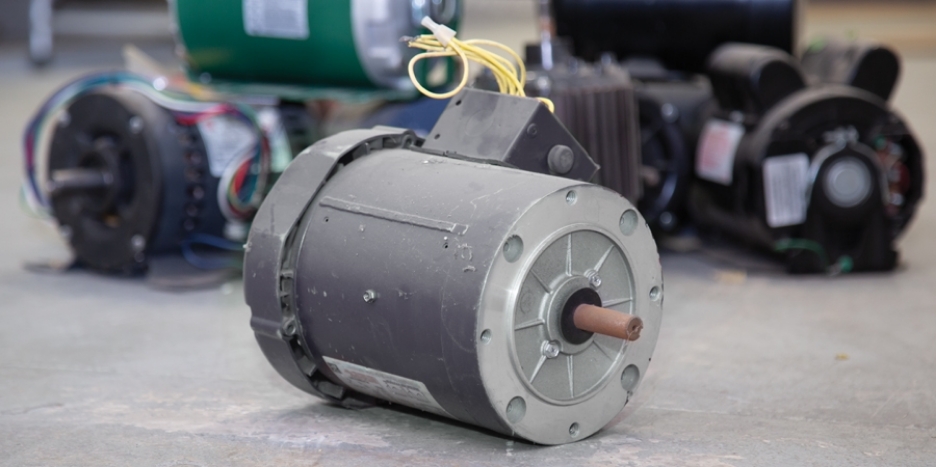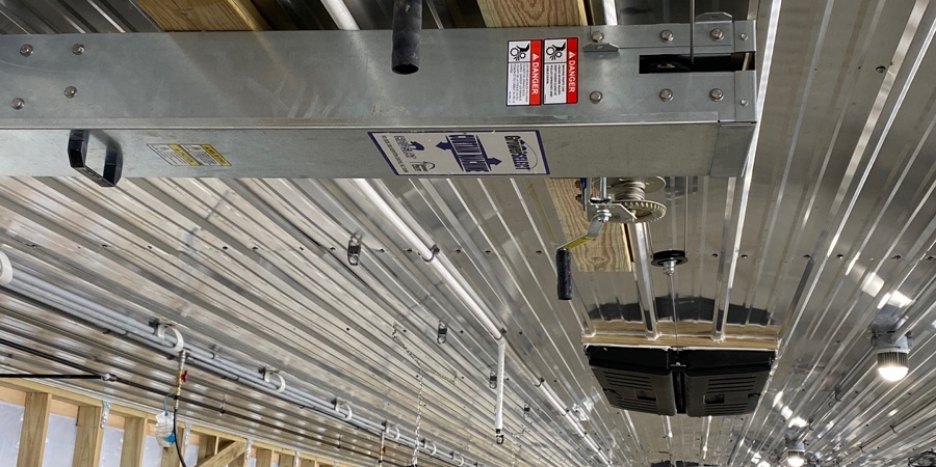Blog posts tagged with 'GrowerSELECT®'
What is motor short-cycling, and why does it matter?
Automated ceiling inlets offer a time-saving alternative to gravity air inlets
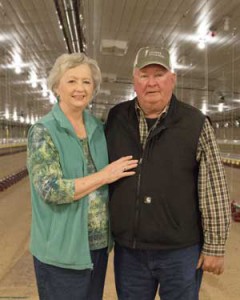
Gene and Phyllis Williams
“The chicken business works good with land and cattle,” Gene Williams commented as he looked out across the pasture next to his farm outside of Everett Springs, GA. “The land gives you a place to spread the litter; the chicken litter builds up the pastures, and the poultry checks provide a steady income when cattle prices are tough.”
Gene and Phyllis Williams have included poultry farming in building their family’s business for over 40 years. Starting with a registered Angus herd, they expanded into the poultry business by leasing two breeder houses in 1975, followed by building three new broiler houses in 1978. In 1994, the family business grew to include The Calhoun Stockyard, and again when oldest son Michael and his wife Shelby made the decision to build four new broiler houses in 2003.
Their middle son, Adam, and wife Jenny moved back to the farm in 2013. In 2014, the two older sons joined with younger brother, Jacob, and his wife Natalie, to purchase a neighboring land tract to form the Circle W Ranch entity. Central to this expansion was the construction of eight 66′ x 600′ broiler houses, each capable of holding 62,000 birds per flock.

Circle W Ranch with Eight 66′ Wide Broiler Houses near Everett Springs, GA.
The tunnel ventilated houses feature Windstorm 54″ exhaust fans, Hog Slat EVAP Systems, and TEGO tunnel doors, regulated by a Rotem control system. The GrowerSELECT feed system utilizes Classic Flood feed pansalong with supplemental feeders in the brooder section. One notable feature is a dedicated feed line with Hi-Grow feeders, used for the first ten days of a new flock and then winched up out of the way. Also, a special hanger line above each feed line permits storage of the Hi-Grow feeders inside the house.
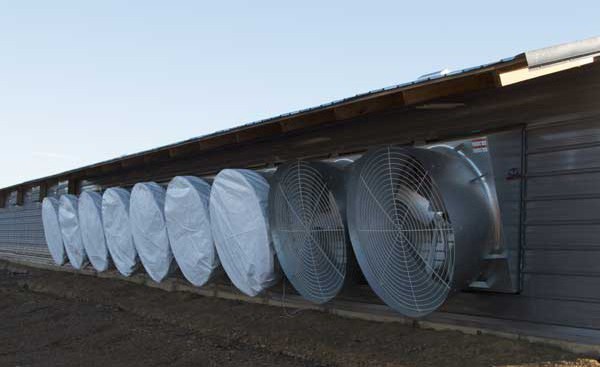
Windstorm 54″ fans power the ventilation system. Shown with winter fan covers to reduce energy loss.

TEGO tunnel doors seal up cool cell openings and direct air up and across the ceiling to promote proper mixing.
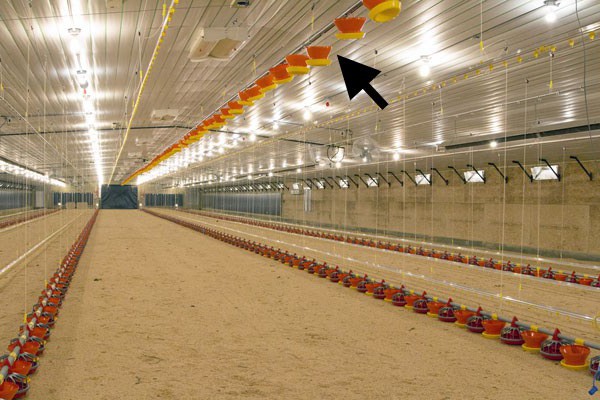
Black arrow highlights dedicated starter line in raised position with feeders attached
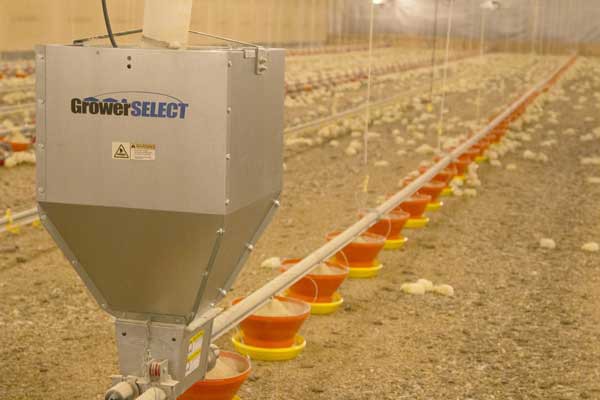
The dedicated feed line for supplemental feeding in the brood area.
Still actively involved in the daily farming operations, Gene and Phyllis continue to influence the education and work ethic of the ten grandchildren joining the family workforce.

Three generations of the Williams family.
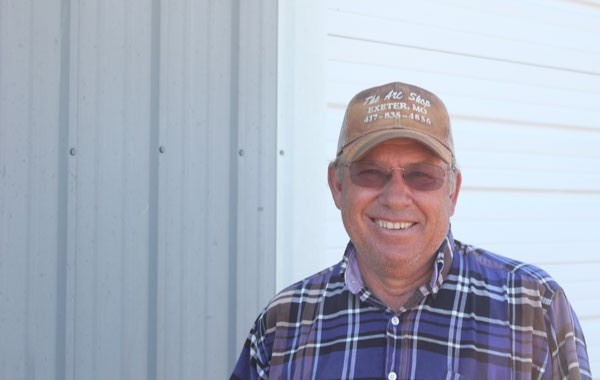
“Our old feeders just weren’t allowing us to compete with some of the newer barns around the area. Our very first flock with new Classic Flood feeders settled at # 1″, explained Exeter, MO grower, C.L. England.
“We felt like changing out the feeders in our 29-year old buildings was a cost effective way to lower our production costs. We proved that out with .2 improvement in feed conversion on the first flock.”
“One of the biggest factors is probably the flood feature of the new pans. With our old pans, we had to hand-fill feeders with extra feed when starting a flock. With the Classic Flood feeders, we just drop the feeders and the pans fill with feed automatically. Getting extra feed into the chicks at the start makes a big difference at settlement.”
“I’m pleased we made the change as it appears it’s an investment that will pay us back quickly,” said C.L.
The size of individual sow farms continues to increase; just a few years ago 2,400 head units were considered large, but new sow farms under construction this year range between 5,000 to 14,000 head in size.
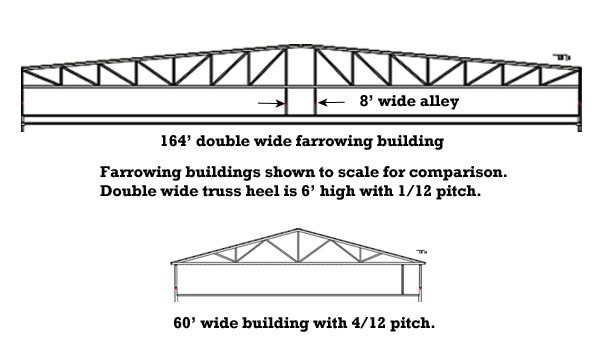
Building cross-section comparison
Designing the central production facility into two or three larger buildings has many advantages including smaller land requirements, less underground utilities to bring to the site, shorter roadways to build and maintain, fewer walkways between buildings and less linear footage of exterior building walls.
Because of increased pig capacities and the desire to minimize the number of buildings, it was necessary to increase the buildings widths up to 190 feet. Instead of the 4/12-pitch roof used on standard farm buildings, these jumbo-wide facilities utilize a two-piece rafter with a 1/12-pitch roof line resting on a center support wall in the middle. Almost 6 feet high at the heel with a center height of 13 feet, the rafters are designed more like a large floor joist. The outside appearance resembles a steel frame building more than conventional wood framed structures.
Breeding/ Gestation

Galvanized gestation stalls
Totally slatted flooring is a common feature of newly constructed B&G buildings. While past layouts consisted of a solid laying area with slat sections in the rear of the pen or stall only, new construction plans incorporate slats over the entire floor with stainless feeding troughs fastened in place. This arrangement allows long-term flexibility to reconfigure the pen layout in the future if needed.
Group housing with stanchions is the predominant type of housing under construction this year. Largely through trial and error, the industry seems to have settled into pen configurations containing eight to twelve sows. This pen size permits closer grouping by size and condition and promotes easier visual inspection.
Whether the production system chooses gestation stalls, stanchions, or ESF, most equipment is specified with hot-dipped galvanized equipment instead of painted finish. The extended equipment life provided by the galvanized finish makes this an economical business decision.
One advantage reported with stanchion systems is longer equipment life resulting from moving the water away from the front of the stanchions. Locating a cup or swinging water pipe with nipples in the center of the pen reduces the deterioration of feed pipes and stall fronts by minimizing water contact with these areas.
Farrowing
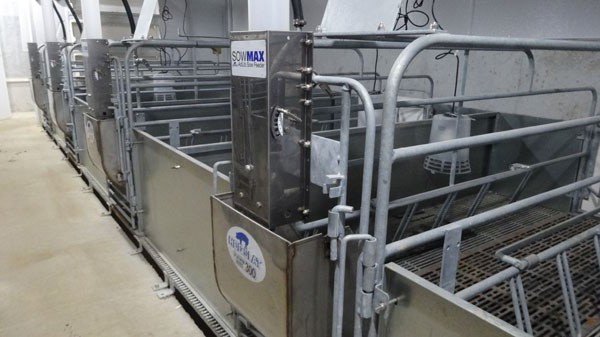
Large pen farrowing crates with SowMAX feeders
Jumbo style layouts permit designing a double farrowing building with an extra wide 8-foot center alleyway to aid in animal and people movement between rooms.
Almost every new construction project increases the length and width of the farrowing crates and creep area from the standard 5′ x 7′ footprint up to 6’ wide by 8′ long, with some systems choosing 8’6″ long crates. Longer framed sows and reduced piglet crushing rates from using wider pens have driven this trend. Again, the equipment will have a galvanized finish with a combination of cast iron, TriDek, or plastic slats for flooring choices.
Most production systems will incorporate some provision for ad-lib sow feeding. Besides reducing farm labor, ad-lib sow feeding is the most efficient method for feeding individual sows to reach full milk production potential. The type of systems can range from electronic transponder metering devices to sow activated hopper type feed dispensers.
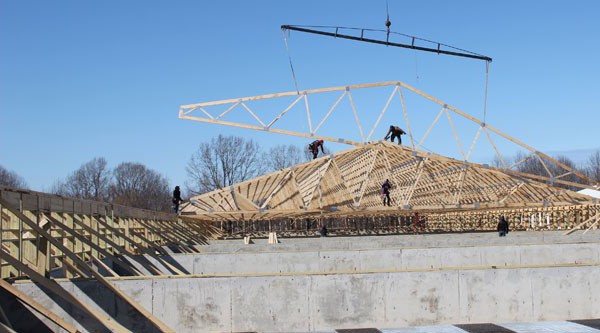
Swinging rafters on new farrowing house
Projects of this size require builders with an expanded skill set. A builder must be able to provide professional project management, understanding of regulatory issues, and increased insurance coverage. It is also critical for any construction firm undertaking projects of this size to have sufficient financial backing and the ability to manage large cash flows.
For more information about Hog Slat’s construction projects and swine production equipment offerings, contact your nearest sales representative by clicking here.
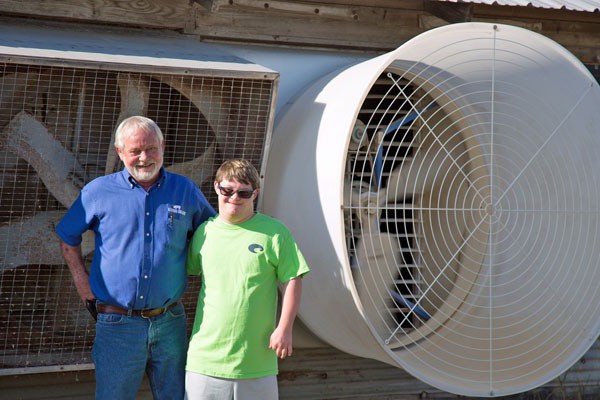
Rodney and Brett Bowden with new Airstorm 54″ fan
To the best of my knowledge, when we built them in 1989, these were the first tunnel/natural ventilated houses constructed in the state,” explained Rodney Bowden at his family farm near Clinton, NC. “We’ve always had good results in the buildings, but the recent upgrades have improved our performance.”
Rodney added two GrowerSELECT 54″ AirStorm fans per house to increase airspeed and reduce the ambient temperature. The durable AirStorm 54″ fans feature a fiberglass housing, plastic shutters, and a stainless steel prop.
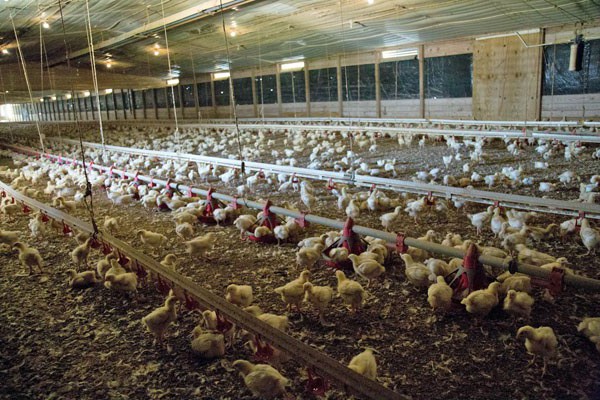
GrowerSELECT Classic Flood feed pans
The next step in the upgrade was to replace the original feed pans with GrowerSELECT Classic Flood feeders. Rodney said, “Installing the new pans helps minimize wasted feed when the birds are young and has improved my feed conversion during grow out.”
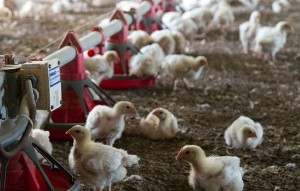 These investments have paid off with an increased bird performance and helped Rodney settle in first place among his group several times since the upgrade.
These investments have paid off with an increased bird performance and helped Rodney settle in first place among his group several times since the upgrade.
Click GrowerSELECT for more information about our quality feeding and ventilation systems.
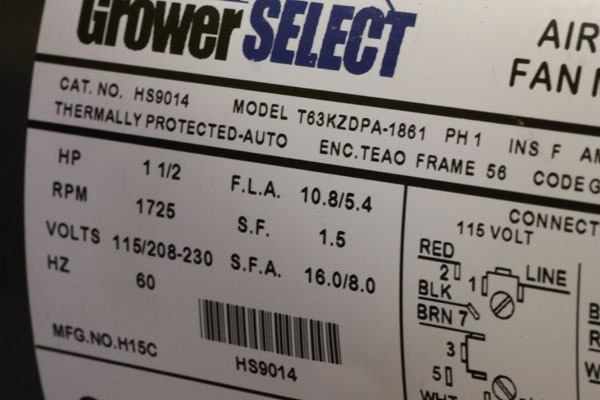
Nameplate from GrowerSELECT fan motor
Today’s livestock and poultry operations rely on electric motors for a variety of feeding and ventilation functions. Used in buildings that can be both dusty and humid, with fluctuations in voltage and varying workloads we subject our motors to a very hostile work environment.
When selecting replacement motors, it is important to select motors that are both efficient and designed with a “safety factor” that will allow them to last under harsh conditions.
While you may be familiar with the term Service Factor or S.F., there are a couple of important designations found on a motor nameplate that may need more clarification.
Service Factor is defined as a motor’s ability to operate under a short-term load. The higher a motor’s S.F. rating, the more durable the motor. Motors with high S.F. are expected to last longer. To illustrate, a 1-1/2 Hp motor with a 1.5 S.F. can provide 2.25 Hp for short-term use. However, it is not a good practice to continuously operate a motor above the rated workload. In other words, the same 1-1/2 Hp motor with 1.5 SF would not be selected to power a 60″ fan originally shipped with a 2 Hp motor.
Full Load Amps or F.L.A. represents the amount of current the motor is designed to draw at the rated horsepower. In the example nameplate, this means that when the motor is running under a full load at 230 volts, we can expect it to draw 5.4 amps. Motors with a lower F.L.A. for the amount of horsepower are considered more efficient to operate.
Service Factor Amps or S.F.A. represents the amount of current the motor will draw when running at the full Service Factor. In the example nameplate, the S.F.A. is eight amps at 230 volts.
Continually exceeding the S.F.A. shown on the nameplate can shorten motor life. Motors with a higher S.F.for the same horsepower have an increased “safety factor” and are expected to last longer under harsh conditions.
The most efficient, rugged motors are designed with a higher S.F., lower F.L.A., and higher S.F.A ratings. By comparing the information on a motor nameplate, we can select the best replacement motors for feeding and ventilation equipment.
Hog Slat designed the GrowerSELECT line of motors to help simplify a producer’s decision on selecting replacement motors. GrowerSELECT motors feature a high Service Factor (as high as 1.5) and higher S.F.A. rating to increase motor life. Each model number is a direct cross to the most popular brands of feed systems and fans used on producers’ farms. No matter what your existing brand of equipment we have a GrowerSELECT motor designed to replace it and save money while doing so. Shop GrowerSELECT motors.

GrowerSELECT Proxy Control on display at the 2016 World Pork Expo
One of the products Hog Slat introduced at the 2016 World Pork Expo is designed to give pork producers an improved method for controlling feed line motors.
The GrowerSELECT Proximity Drop Tube Control features a flat proxy sensor that can detect feed levels through the plastic housing. The flat proxy mounts to the side of the feed tube and doesn’t require drilling a hole for installation. The compact design takes up less room on the control compared to rod type proxy sensors.
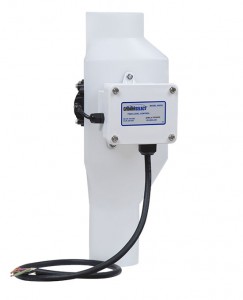
GrowerSELECT HS752

Flat Sensor
Like it happens with many advancements in electronics this improved sensor costs less than existing technology. A quick online search shows replacement rod type proxy switches costing between $117 and $150. The complete HS752 unit costs $125 and can replace the feed level control on any existing feed system.

Close up of sensor mounted on control
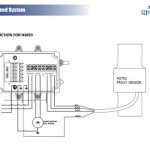
Simple wiring diagrams for existing feed systems.
Click here for manual illustrating wiring schemes for installing the HS752 on the most common feed systems.
To order go to www.hogslat.com , stop at a local store (see store locator) or call 800-949-4647.
At one time or another, almost ever poultry grower has walked into a house and found empty pans caused by a malfunctioning control pan. These unplanned feed outages cause broiler performance to suffer and potential lost revenue at close out.
Control pans using mechanical paddle switches are subject to failure when fine feed dust packs in behind the paddle. When the fabric diaphragm, protecting the switch, becomes torn this can happen even more frequently.
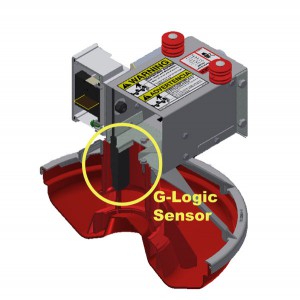
Advanced G-Logic sensor replaces mechanical paddle switches.
The new G-Logic Control Pan utilizes a different type of switch to prevent this kind of feed outage from occurring. The G-Logic Sensor replaces mechanical switches with the most accurate solid-state technology available today. It electronically detects when the feed level fills the control pan and shuts the feed line motor off. After the level drops and calls for the feed line to start, a preset 60-second delay prevents short-cycling to improve motor life.

Encapsulated solid-state sensor
The G-Logic sensor has no moving parts to wear out, no adjustment screws and no fabric diaphragms to replace. Unlike open mechanical button switches, the sensor is sealed from harsh poultry house environments.
The G-Logic control pan comes complete with a 10′ pigtail cord and 18″ cord protector. It’s an 115/230 volt unit with an 8-spoke grill. It’s available at any Georgia Poultry, Eastern Shore or Hog Slat store near you. Go online at www.gapoultry.com or call 800-949-4647.
- 2025
- 2024
- 2023
- 2022
- 2021
- 2020
- 2019
- 2018
- 2017
- 2016
- 2015
- 2013












 Україна
Україна Méjico
Méjico